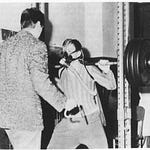
Participation in physical exercise is important for one’s mental and physical wellbeing. Decades of research supports this conclusion. With such evidence in their back pockets, some exercise activists have started to proclaim that physical activity is a “right.” For example, a group in England called the Sport and Recreation Alliance is petitioning government to “give every child the fundamental right to be active.” The Alliance has stated that it wants the passage of laws that require councils to “provide all children with the opportunity to be active and to coordinate and promote physical activity across everything they do.” Moreover, the Alliance wants government to create a “long-term, properly funded and child-focused strategy to transform the physical and mental wellbeing of our children.”
Perhaps one might think that this does not sound so bad. After all, do we not want more children to be physically active? Of course, we do. But hang tight – let us dig deeper to see the underlying intellectual explanation of physical activity as a “right.”
Such an explanation can be found in a paper by Messing and colleagues published in the Health and Human Rights Journal in 2021. In their paper, the authors argue that the “right” to be physical activity can be “derived from well-established human rights such as the right to health, the right to rest and leisure, the right to education, and the principle of non-discrimination.”
Messing and colleagues go on to characterize this right by four dimensions: availability, accessibility, acceptability, and quality. In their conception of physical activity as a “right,” availability means that indoor and outdoor facilities for exercise be made available to everyone. Accessibility means that facilities for physical activity be within “safe reach” and that the services provided at such facilities be affordable. Acceptability means that all spaces for physical activity are “culturally appropriate,” meaning that physical activity should “respect the culture of participating individuals and are sensitive to gender and life-cycling requirements.” Quality means that facilities, goods, and services for physical activity be “scientifically and medically appropriate and of good quality” and that skilled medical personnel be there to deliver the activity.
Thus, for Messing and colleagues and the Sport and Recreation Alliance, the “right” to physical activity means that indoor and outdoor spaces and services for exercise be made available to everyone and that these spaces be affordable, high-quality, inclusive, and nearby. But, is guaranteeing people access to things that are free or low-cost really the definition of a right? Here, I want to explain that physical activity is indeed a right but only when the concept is properly defined.
According to the novelist and philosopher, Ayn Rand, a right is “a moral principle defining and sanctioning a man’s freedom of action in a social context.” According to Rand, the concept of a right “pertains only to action – specifically, to freedom of action. It means freedom from physical compulsion, coercion or interference by other men.”
Thus, when objectively defined, the right to physical activity is that the movement of your body shall not be infringed upon by others, including governments, so long as the physical activity that you are participating in does not simultaneously infringe upon someone else’s rights. This right is not granted to you by government. It’s your natural right as a human being. The proper purpose of government is to protect such rights – that is, to ensure that others do not infringe upon your physical activity.
This is not the same concept put forward by exercise activists such as Messing and colleagues and the Sport and Recreation Alliance. They seek to use the coercive powers of government, such as through taxation and resource redistribution, to exert control over those who create and provide exercise products and services. Thus, their concept of physical activity as a right is untenable within objective law because it involves violating the private property rights of other individuals. In their view, the role of government is to provide physical activity. In my view, the role of government is to protect physical activity – that is, to ensure no one violates your desire to engage lawfully with the exercise spaces, products, and services of your choosing.
Ironically, an example of the government’s infringement upon the right to physical activity occurred on an international stage during the COVID-19 pandemic. Governments mandated lockdowns which severely restricted human mobility. A number of studies have documented that during lockdowns physical activity decreased and body weight increased. Additional research has documented that physical activity levels negatively correlate with adverse outcomes from COVID-19; individuals who were most physically active before or during the pandemic were the least likely to experience severe symptoms including death from the virus. The inability of medical and public health officials to understand the multifactorial nature of human health during the pandemic is a searing indictment on the current status of higher education programs in the areas of medicine and public health.
Moreover, even when full-fledged lockdowns were lifted, some restrictions in physical activity still applied. For example, governments limited access to parks and gyms. One irony of the concept of physical activity as a “right” is that “access” and “inclusion” are part of that proposed concept. Yet, we know that this supposed desire to make physical activity more accessible and inclusive is ingenuine and unprincipled. How do we know this? Because during the COVID-19 pandemic there was a specific group of people for whom governments purposely limited mobility and social interaction, including at fitness centers. These people were shamefully labelled the “unvaccinated.”
The reason that it can be confusing to understand the concept of physical activity as a right is because exercise activists have hijacked “right” as a word and concept. Redefining words is a common tactic employed by activists of the collectivist orientation. These individuals have a long history of attempting to change definitions of words to accomplish their political aims – the most fundamental of which is to obtain more power. In the case of physical activity as a “right,” activists combine two concepts – exercise and freedom – that the lay public intuitively feel or consciously know to be important, but then use this public sentiment to turn the concept of a right on its head. That is, when an individual disagrees that physical activity is a “right,” activists then claim that that individual does not believe that exercise or rights are important. This, of course, is untrue.
As Ayn Rand once said, “Any alleged ‘right’ of one man, which necessitates the violation of the rights of another, is not and cannot be a right.” I, like most other exercise scientists know that participation in physical exercise is good for one’s mental and physical wellbeing. However, physical activity as a “right” is untenable because it involves simultaneously violating the private property rights of other individuals. Physical activity is, indeed, a right, but only when such a concept is properly defined. The role of government is not to provide you with rights, but to protect them. May we never forget the time in which governments failed miserably to protect our right to be physically active, and instead, were the main violators of this right.
Related Content at The Nuzzo Letter
SUPPORT THE NUZZO LETTER
If you enjoyed this content, please consider supporting The Nuzzo Letter with a one-time or recurring donation. Your support is greatly appreciated. It helps me to continue to work on independent research projects and fight for my evidence-based discourse.















